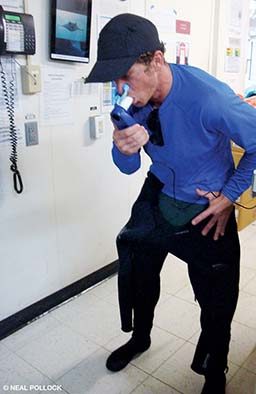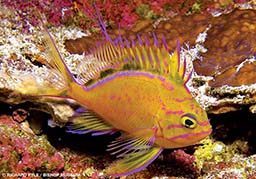Papahānaumokuākea Marine National Monument (PMNM) in the Northwestern Hawaiian Islands is the largest marine conservation area in the United States and one of the largest in the world. Its atolls, islands, reefs, pinnacles and surrounding habitats make up one of the last expansive wild places on Earth.
Until recently, coral reef research has focused on the shallowest one-third of reef habitat, leaving deeper regions mostly unexplored. As a result, many species have remained unidentified or even undiscovered. But as coral reefs continue to be threatened, supporting habitat and species diversity is increasingly critical. The National Oceanic and Atmospheric Administration (NOAA) recognizes that extensive exploration of these reef systems is integral to understanding the contributions of Hawaii’s reefs to overall global biodiversity. Scuba diving operations are a necessary element of this exploration, but the long-term physiological impacts of these deep dive exposures are not completely understood. Divers must rely on dive computers, mathematical models and decompression algorithms that have undergone only limited testing on humans. As a result, significant gaps in knowledge exist.
Studying the biodiversity of the Hawaiian archipelago using scuba has given scientists a unique opportunity to monitor the physiological impacts of deep dives and thus expand our knowledge of diving science, particularly decompression risk.
The Divers and Equipment
The deeper regions are of particular interest because of the potential protection and support they provide for shallow reef systems during and following environmental disturbances.1 Mesophotic (meso meaning middle, photic meaning light) coral ecosystems, found in tropical and subtropical regions from about 100 feet to 500 feet, are extensions of shallower coral environments. Reef-building corals in Hawaii have been recorded as deep as 500 feet. These reefs had never been explored prior to the commissioning of the NOAA ship Hi’ialakai, which has conducted mesophotic research cruises for six years now.
While remotely operated vehicles (ROVs) and submersibles can be used at these depths, they have some shortcomings. Manned submersibles and support ships can cost more than $50,000 a day. The limited mechanical dexterity of subs and ROVs makes them poor options for collecting nimble or delicate marine life. When conducting visual fish censuses, use of large, noisy hardware can make it difficult to approach marine life, especially compared to divers using minimally intrusive closed-circuit rebreathers (CCRs).
Physiology and Decompression Stress
Decompression sickness (DCS) consists of a constellation of symptoms that result from decompression stress in excess of what can be tolerated. A number of variables affect decompression stress. How these variables ultimately influence DCS risk, independently and in concert, is not well understood. Improved knowledge of decompression stress could help researchers determine what factors may be playing a role at different points in time. The challenge is in understanding how and when multiple factors may or may not be important. Both lab and field studies are necessary to better understand decompression stress and risk.
Lab studies in a controlled environment such as a hyperbaric chamber are a critical element in evaluating the impact of factors such as pressure, exercise and thermal stress on DCS risk. The ability to isolate these and other variables is an important benefit of lab research. Field studies are less controlled, but they incorporate realistic conditions that generally cannot be fully reproduced in the lab. In field studies, multiple factors work together to produce an overall impact on physiology and, subsequently, DCS risk. Although the idiosyncrasies of field studies can make it challenging to test hypotheses and develop publishable science, the results can better reflect real-world activities.
The latest NOAA expedition was organized by Randall Kosaki, Ph.D., deputy superintendent of research and field operations. This project included collaborative work with a scientific team from DAN® led by DAN research director Neal Pollock, Ph.D. The collaboration gave these researchers access to an extensive dive series that would be both difficult and expensive to set up in a lab.
Field Dive Monitoring

Studying decompression dive profiles in the field presents a unique opportunity to better understand the impact of these exposures, particularly on bubble formation and DCS risk. Being able to follow a single group of divers for an extended period offers insights that could not be found in a shorter series. NOAA’s facilities and pool of scientific and working divers support a broad range of dives. Typically, NOAA divers dive 20-minute bottom times at 280-330 feet followed by approximately 80-120 minutes of decompression.
Subjects in field dive-monitoring studies have access to real-time measures of decompression stress following their dives. For example, transthoracic echocardiography (TTE) uses ultrasound to create moving images of the chambers of the heart and any visible bubbles that may be present postdive. Both the subjects and the program benefit by viewing such measures of decompression stress that they would normally not be able to see. The resulting insights can prompt modification of individual behaviors and possibly even the operational practices of the dive program. Improved use of conservatism in risk management may lead to increased consideration of idiosyncrasies in human physiology, which has relevance for all divers.
Collaborative Efforts
Studying scientific divers engaged in dynamic and extreme dive profiles provides an opportunity to see whether the dive computers and models on which they rely adequately control for bubble formation. It also provides an opportunity to study whether more conservative settings might help reduce the risk of DCS. Better understanding of the interplay between decompression stress and the various factors that affect physiology can provide insights into DCS risk. The lessons learned through this research may lead to safer diving, not just for these research divers but for the entire scientific and possibly recreational diving communities.
References
- Muir P, Wallace C, Bridge TCL, Bongaerts P. Diverse staghorn coral fauna on the mesophotic reefs of North-East Australia. PLoS One. 2015; 10(2): e0117933.
Learn More
The Vessel
Hi‘ialakai, Hawaiian for “embracing pathways to the sea,” is a critical part of the mission to explore, understand and protect the coral reef habitats of PMNM. Its scientific operations include field studies that map coral reef ecosystems, perform bioanalysis assessments, gauge coral reef health and study fish stocks. In addition to carrying small work boats for transporting divers to and from working areas, the 224-foot research vessel also carries a three-person, dual-lock recompression chamber; in the event of a dive accident, the diver can be treated on site.

New Species
The number of known fish species in PMNM has grown by more than 25 percent, which amounts to a significant increase in known biodiversity. More than 70 species of colorful algae formerly unknown to science have been collected. The latest expedition discovered that the fish communities on deep reefs at 330 feet at Kure Atoll (the northernmost reef in the Hawaiian archipelago) are composed of 100 percent endemic species (species found nowhere else). This is a level of endemism never before seen in any other marine ecosystem on Earth.
| © Alert Diver — Q1 2017 |